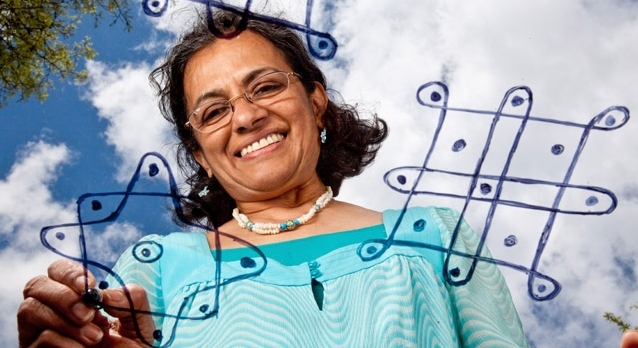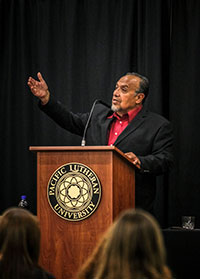Page 58 • (12,759 results in 0.034 seconds)
-
. She got caught, and was turned over to the Nazis. She was immediately put on a train to Auschwitz. The year was 1944. When she got off the train, a Jewish woman from her hometown recognized her, and got her the job that would ultimately help save her life. Her job was to collect the clothes of those being taken into the gas chambers. Day in and day out, Georgette sorted the clothes of innocent people being herded to their deaths. The death marches started in late 1944 and into 1945. It was one of
-
. She got caught, and was turned over to the Nazis. She was immediately put on a train to Auschwitz. The year was 1944. When she got off the train, a Jewish woman from her hometown recognized her, and got her the job that would ultimately help save her life. Her job was to collect the clothes of those being taken into the gas chambers. Day in and day out, Georgette sorted the clothes of innocent people being herded to their deaths. The death marches started in late 1944 and into 1945. It was one of
-
. She got caught, and was turned over to the Nazis. She was immediately put on a train to Auschwitz. The year was 1944. When she got off the train, a Jewish woman from her hometown recognized her, and got her the job that would ultimately help save her life. Her job was to collect the clothes of those being taken into the gas chambers. Day in and day out, Georgette sorted the clothes of innocent people being herded to their deaths. The death marches started in late 1944 and into 1945. It was one of
-
. She got caught, and was turned over to the Nazis. She was immediately put on a train to Auschwitz. The year was 1944. When she got off the train, a Jewish woman from her hometown recognized her, and got her the job that would ultimately help save her life. Her job was to collect the clothes of those being taken into the gas chambers. Day in and day out, Georgette sorted the clothes of innocent people being herded to their deaths. The death marches started in late 1944 and into 1945. It was one of
-
. She got caught, and was turned over to the Nazis. She was immediately put on a train to Auschwitz. The year was 1944. When she got off the train, a Jewish woman from her hometown recognized her, and got her the job that would ultimately help save her life. Her job was to collect the clothes of those being taken into the gas chambers. Day in and day out, Georgette sorted the clothes of innocent people being herded to their deaths. The death marches started in late 1944 and into 1945. It was one of
-
Wednesday, Oct. 5 “Beyond the Horizon: The Legacy of Nordic Explorers” exhibitExamining the motivations and actions of explorers ranging from Leif Eriksson 1000 years ago to modern day astronauts, this exhibition features such iconic figures as Thor Heyerdahl, Roald Amundsen, and Fridtjof Nansen. Artifacts, artworks, photographs, and informative, compelling stories bring these figures to life, revealing why we continue to find them inspirational today. Through this exhibit, learn about the rich
-
May 18, 2009 The finish line The call came from Japan as Masahide Nishimura was finishing up his degree in Chinese Studies at Pacific Lutheran University a decade ago. His grandfather, Jisaburo Nishimura, 92, had had a stroke. Masahide felt he needed to come home and support his grandfather, who had raised him, and help with the family business – Kobe Toyopet Corp. – which distributes Lexus, Toyota and Volkswagen cars. This was a company started by his grandfather some 50 years earlier. “I
-

July 1, 2011 PLU Associate Professor Vidya Thirumurthy draws a kolam, an artful design that Hindu households use to communicate with their community. (Photo by John Froschauer) Connecting the dots: Letting neighbors know “all is well” with the world By Steve Hansen, Scene Editor Each morning, on the doorstop of every home in Vidya Thirumurthy’s hometown of Chennai – indeed, in much of Southern India – women and girls create what’s known as a kolam out of rice flour. An intricate geometric
-

are made and amended with the changing nation. “While I love the Constitution, I know it has to changed,” Rose-Avila said. “To the future we are going to, there is no GPS. We have to create it.” He talked about how immigration has been a problem since the beginning of the United States. Avila described how Cuban immigrants are allowed to stay in the U.S.A. if they get one foot in America. However, it is not the same for immigrants from other nations, Rose-Avila said. Rose-Avila helps immigrants
-

from a technology consulting company, Pariveda Solutions, in Fall 2013. He had met a recruiter from the company at Pacific Lutheran University’s Career Expo, hosted every spring on campus to bring together successful organizations, companies and students. Students who attend can connect with company representatives and gather job information. It turned out that Pariveda didn’t have an available position at the time, so the company guaranteed Stegemoeller, an Applied Physics/Computer Science double
Do you have any feedback for us? If so, feel free to use our Feedback Form.


